
Last week, the Lectionary pointed us toward 2 Samuel 7:1-14. This passage tells us of King David's desire to build a Temple for his God. David shares this desire with the prophet Nathan, who at first recognizes this as a noble sentiment. David, after all, is seeking to offer up his best for the Lord. He finds himself uncomfortable living in luxury while the Ark (and the presence of God) are relegated to a tent at the edge of town.
Nathan is thrilled that David's conscience has been pricked in this particular way, and announces that God's hand is on the king. Nathan, like many of us, has probably seen way to much of the attitude that assigns God as the recipient of our leftovers and cast-offs. He sees in David a man who would give God a worthy gift.
He is surprised, then, when God visits him in a dream and announces that he doesn't want a Temple. God instructs Nathan to stop David, to tell David that no Temple is necessary:
5 "Go and tell my servant David, 'This is what the LORD says: Are you the one to build me a house to dwell in? 6 I have not dwelt in a house from the day I brought the Israelites up out of Egypt to this day. I have been moving from place to place with a tent as my dwelling.
7 Wherever I have moved with all the Israelites, did I ever say to any of their rulers whom I commanded to shepherd my people Israel, "Why have you not built me a house of cedar?" '
God asserts that he never asked for a Temple. Further, he reminds David that his Temple is wherever his people go:
8 "Now then, tell my servant David, 'This is what the LORD Almighty says: I took you from the pasture and from following the flock to be ruler over my people Israel. 9 I have been with you wherever you have gone...
God is perfectly comfortable in a "mobile" home. He never sought to tie himself to a place, but to a people. He seems touched, however, by the sincerity of David's offer, and responds with a promise:
" 'The LORD declares to you that the LORD himself will establish a house for you: 12 When your days are over and you rest with your fathers, I will raise up your offspring to succeed you, who will come from your o
 wn body, and I will establish his kingdom. 13 He is the one who will build a house for my Name, and I will establish the throne of his kingdom forever. 14 I will be his father, and he will be my son. When he does wrong, I will punish him with the rod of men, with floggings inflicted by men. 15 But my love will never be taken away from him, as I took it away from Saul, whom I removed from before you. 16 Your house and your kingdom will endure forever before me b]">[b] ; your throne will be established forever.' "
wn body, and I will establish his kingdom. 13 He is the one who will build a house for my Name, and I will establish the throne of his kingdom forever. 14 I will be his father, and he will be my son. When he does wrong, I will punish him with the rod of men, with floggings inflicted by men. 15 But my love will never be taken away from him, as I took it away from Saul, whom I removed from before you. 16 Your house and your kingdom will endure forever before me b]">[b] ; your throne will be established forever.' " Ensuing generations of Jews take verse 13 to apply to Solomon, who does indeed build the first Temple in Jerusalem. Solomon's Temple, however, like his throne, turns out to be tem
 porary in nature. It falls into disrepair and must be extensively repaired, first by Josiah, and later by Hezekiah. Finally, it is destroyed by an invading force. The Prophets insist this invasion is the consequence of Israel's sin.
porary in nature. It falls into disrepair and must be extensively repaired, first by Josiah, and later by Hezekiah. Finally, it is destroyed by an invading force. The Prophets insist this invasion is the consequence of Israel's sin.After the Babylonian Exile, Ezra rebuilds the Temple and calls upon the people to renew their covenant with God. A few generations later, though, this Temple is desecrated by the Persians under Antiochus Epiphanes. The stones of the altar are scattered and the sacrifices once again come to a halt. The Maccabees rebel against the Persians and rebuild the Temple altar and resume the sacrifices, but many of their contemporaries find the new Temple order to be polluted by a corrupt and unqualified priesthood.
The Temple itself receives a major overhaul under King Herod. As an edifice, Herod's Temple was noted by many in its day to be the most spectacular place of worship in existence. Herod radically expanded the Temple Mount to include a vastly larger courtyard for the Gentiles. His building project involved fillinf in a valley between to adjacent mountaintops, and extending the southern hilltop some distance into the city by building a massive retaining wall some fifty feet high. Be built massive public entrances, including a large ceremonial stoa to the south (The Southern Stairs) a broad, winding staircase connecting to the Roman Cardo (Robinson's Arch) and an elevated causeway that connected the wealthy palace district to the Temple so that the Priests and other powerful patrons could enter the Temple without mingling with the rabble.
For all of its grandeur, however, Herod's Temple was still governed by an illegitimate priesthood. Herod himself, in fact, was not even Jewish, much less a descendant of David. Priest and King alike were all puppets of Rome who carefully oversaw all that happened in the Temple district. The Romans actually occupied a fortress adjacent to and overlooking the Temple courts. They also held the priestly vestments under lock and key, guaranteeing that no worship could take place without their say so. Many Jews in the days of Herod found all of this objectionable and refused to recognize the authority of the Temple as it now stood.
Among these was a travelling rabbi from Galilee by the name of Jesus who entered the Temple gounds just before Passover and declared them "desolate." he symbolically overturned the tables of the moneychangers and drove out the sacrificial animals. He spoke of his own body as the true Temple and indicated that if it were destroyed, it could be raised back up in three days.
This was an understandably dangerous statement. Jesus' words and actions in the Temple undercut the entire political power structure of Jerusalem and Israel in his day. Eventually, it is for his words against the Temple that Jesus is found guilty of sedition and he is crucified.
One of his early followers, a man named Stephen, is also accused of speaking against the temple. He is stoned to death for this impertinence, but not before he preaches a lengthy sermon, including a reference to David's aborted desire to build a Temple:

7:45Having received the tabernacle, our fathers under Joshua brought it with them when they took the land from the nations God drove out before them. It remained in the land until the time of David, 46who enjoyed God's favor and asked that he might provide a dwelling place for the God of Jacob.k]">[k] 47But it was Solomon who built the house for him.
48"However, the Most High does not live in houses made by men. As the prophet says:
49" 'Heaven is my throne,
and the earth is my footstool.
What kind of house will you build for me? says the Lord.
Or where will my resting place be?
50Has not my hand made all these things?'l]">[l]
51"You stiff-necked people, with uncircumcised hearts and ears! You are just like your fathers: You always resist the Holy Spirit!
Stephen's point seems to be that Solomon's Temple was a mistake from the word go. God's intention had never been to live in a Temple, but for his Spirit to dwell in the lives of his people. God preffered a mobile home. This sort of talk got him killed.
Among those who attended on Stephen's stoning was a man named Pauls, who would later write to his own followers in Corinth:
1 Corinthians 3:16Don't you know that you yourselves are God's temple and that God's Spirit lives in you? 17If anyone destroys God's temple, God will destroy him; for God's temple is sacred, and you are that temple.
Another of Jesus' followers, Peter, noted that much of what Paul wrote was "difficult to understand." However, on the notion of what constituted the true Temple, he evidently agreed:
1 Peter 2:4As you come to him, the living Stone—rejected by men but chosen by God and precious to him— 5you also, like living stones, are being built into a spiritual house to be a holy priesthood, offering spiritual sacrifices acceptable to God through Jesus Christ.
For all of these would be followers of Jesus, then, we find a common notion. The Temple in Jerusalem was a human institution. God's promise to David in 2 Samuel referred to something else: a coming king who would establish a Temple and reign forever. Hmm... let think about it...
A visit to the Temple Ruins in Jerusalem is bittersweet at so many levels. On the one hand, one is able to walk in a place where we can be certain that Jesus walked, and these places are rare, even in the Holy Land. On the other hand, no site has been the center of more interfaith conflict. The Temple Mount itself is now virtually off limits to Jews and Christians alike, a Moslem Holy Site.

And then there is a visit to the Western Wall, where devout Jews may be witnessed offering up prayers and weeping bitter tears for a bygone age. They continue to pray (as do many of their Christian counterparts) for the reconstruction of the Temple, unaware that the true Temple was destroyed by our own sinfulness two thousand years ago.
And then raised up.
That the dwelling place of God, the resurrected body of Christ, is now (has always been?) his people.
A mobile home.



















